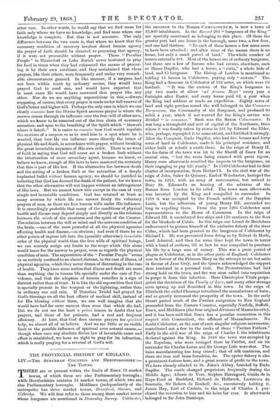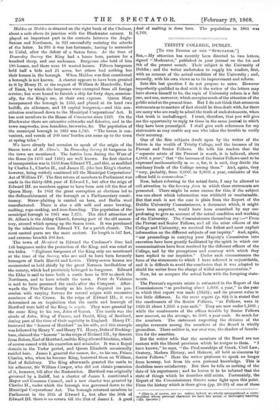THE PROVINCIAL HISTORY OF ENGLAND.
LiV.—THE SUBURBAN COUNTIES AND HERTFORDSHIRE :- TIE TOWNS.
THERE are at present within the limits of Essex 19 market towns, of which three are also Parliamentary boroughs ; while Hertfordshire contains 14 market towns, of which two are also Parliamentary boroughs. Middlesex (independently of the metropolis) has three market towns, Brentford, Staines, and Uxbridge. We will first refer to those among these market towns whose burgesses are mentioned in Domesday Survey. Colchester, the successor to the Roman CAMULODUNUM, is now a town of 23,800 inhabitants. In the Record 294 " burgesses of the King " are specially mentioned as belonging to this place. Of these the greater part had one house in the borough, some two, a few four, and one had thirteen. "To each of these houses a few acres seem to have been attached ; and after some of the names there is no house, but only a small parcel of land." The whole number of houses entered is 401. Most of the houses are of ordinary burgesses, but there are a few of Barons who had estates elsewhere, such as Hamo Dapifer, who had a house, a " curia," a whole hide of land, and 15 burgesses. The Bishop of London is mentioned as holding 14 houses in Colchester, paying only " scotum." The King had a demesne in Colchester of 102 acres, on which were 10 bordarii. " It was the custom of the King's burgesses to pay two marks of silver 'ad firmam Regis' every year a fortnight after Easter, and every house paid 6d. a year when the King bad soldiers or made an expedition. Eighty acres of land and eight perches round the wall belonged to the Commune Burgessium, the Community of the Burgesses, and produced 60 solidi a year, which if not wanted for the King's service was divided " in commune." Such was the Saxon Colneceaster. It was long a stronghold and sort of capital of the Northmen, from whom it was finally taken by storm in 921 by Edward the Elder, who, perhaps, repeopled it to some extent, and fortified it strongly. After the Conquest, Eudo Dapifer, who had five houses and forty acres of land in Colchester, made it his principal residence, and either built or rebuilt a castle there. In the reign of Henry II. the fee-farm of the town was let to the Sheriff of Essex for an annual sum, " but the rents being exacted with great rigour, Henry soon afterwards remitted the imposts to the burgesses, on their engaging to pay 421. yearly." In 1189 Colchester had its first charter of incorporation, from Richard I. In the civil war of the reign of John, Saber de Quincey, Earl of Winchester, besieged the town, in 1215, with an army of mercenaries, but retired to Bury St. Edmund's on hearing of the advance of the Barons from London to its relief. The town soon afterwards was invested by the King and compelled to surrender. In 1218 it was occupied by the French soldiers of the Dauphin Louis, but the adherents of young Henry III. succeeded ere long in expelling them. From the year 1295 Colchester sent representatives to the House of Commons. In the reign of Edward III. it contributed five ships and 170 mariners to the fleet for the blockade of Calais. In this reign one Lionel de Bradeham endeavoured to possess himself of the exclusive fishery of the river Colne, which had been granted to the burgesses of Colchester by Richard I. He was prevented from doing so by Robert de Herle, Lord Admiral, and then for some time kept the town in terror with a band of outlaws, till at last he was compelled to purchase his life by a large sum of money. This was a great period of plague in Colchester, as in the other parts of England. Colchester rose in favour of the Princess Mary on the attempt to set her aside in favour of Jane Grey, and the Queen acknowledged the support thus rendered in a personal visit. But Protestantism had laid strong hold on the town, and fire was soon called into requisition to purge it from this infection. Here Christopher Vitels propa- gated the doctrines of the Family of Love, and many other strange sects sprang up and flourished in this town. In the reign of Elizabeth the exiled Flemings introduced the manufacture of baize, and so greatly increased the prosperity of the town. In the early Stuart period much of the Puritan emigration to New England proceeded from the Eastern Counties, especially Norfolk, Suffolk, Essex, and Middlesex (the four original divisions of Massachusetts), and it has been said that Essex has a peculiar connection in this respect with Connecticut, the offshoot of Massachusetts. No doubt Colchester, as the seat of such singular religious movements, contributed not a few to the ranks of these " Puritan Fathers." Early in the civil war of the reign of Charles I. the inhabitants declared against the King. In 1648 the town was occupied by the Royalists, who were besieged there by Fairfax, and on its surrender Sir Charles Lucas and Sir George Lisle were shot. The baize manufacturing has long ceased ; that of silk continues, and there are iron and brass foundries, &c. The oyster fishery is also a prominent feature here, and a great source of profit to the town. We have already alluded to St. John's Abbey, founded by Eudo Dapifer. The castle changed proprietors frequently during the Middle Ages ; Alberic de Vere, Stephen Harengord, Guido de la Rupe-Ford or Rochford, Richard de Holbrook, Lawrence de Scaccaris, Sir Robert de Renhell, &c., succetsively holding it. James Hay, Earl of Carlisle, in the reign of Charles I. pur- chased the reversion to him and his heirs for ever. It afterwards belonged to Sir John Stanhope. Maldon or Malden is situated on the right bank of the Chehnar, about a mile above its junction with the Blackwater estuary. It
played an important part in the contests between the Anglo- Saxons and Northmen, in 921 successfully resisting the attacks of the latter. In 993 it was less fortunate, having to surrender
to Unlaf, after the defeat of a Saxon force. At the time of Domesday Survey the King had a house here, pasture for a hundred sheep, and one soeheman. Burgesses also held of him 180 houses, and there were 18 wasted houses. Fifteen burgesses held half a hide and 21 acres, but others had nothing but their houses in the borough. When Malden was first constituted a borough is not known. A charter appears to have been granted to it by Henry II. at the request of William de Mandeville, Earl of Essex, by which the burgesses were exempted from all foreign service; but were bound to furnish a ship for forty days, occasion- ally, for the King's use, at their own expense. Queen Mary incorporated the borough in 1553, and placed at its head two bailiffs, six aldermen, and 18 capital burgesses,—and this con- stitution continued down to the Municipal Corporations' Act. It has sent members to the House of Commons since 1329. On the Blackwater there are extensive saltworks and fisheries, and in the town soapworks, iron foundries, breweries, &e. The population of the municipal borough in 1861 was 4,785. "The haven is con- venient, and vessels of 200 tons' burden can come up to the town at spring tides."
We have already had occasion to speak of the origin of the Saxon town of St. Alban's. In Domesday Survey 46 burgesses in the town are mentioned. The battles here during the Wars of the Roses (in 1455 and 1461) are well known. Its first charter of incorporation was in 1553 from Edward VI., and this, as modified by Charles I., Charles II., and James II. (the last King's charter, however, being voided) continued till the Municipal Corporations' Act of William IV. The first return of members to Parliament was made in the thirty-fifth year of Edward L, but after the reign of Edward HI. no members appear to have been sent till the first of Queen Mary. In 1852 the great corruption at elections led to the disfranchisement of the borough as a Parliamentary consti- tuency. Straw-plaiting is carried on here, and Berlin wool manufactured. There is also a silk mill and some brewing, malting, rope-making, and iron-founding. The population of the municipal borough in 1861 was 7,675. The chief attraction of St. Alban's is the Abbey Church, forming part of the old monas- tery, around which sprang up the Saxon town. It was purchased by the inhabitants from Edward VI. for a parish church. The most central parts are the most ancient. Its length is 547 feet, and extreme breadth 206 feet.
The town of Hertford in Edward the Confessor's time had 146 burgesses under the protection of the King, and was rated at ten bides. " Eighteen burgesses of the King only are mentioned at the time of the Survey, who are said to have been formerly homagers of Earls Harold and Lewin. Thirty-seven houses are enumerated as held chiefly by the great Norman landholders of the county, which had previously belonged to burgesses. Edward the Elder is said to have built a castle here in 909 to check the Northmen, and to have rebuilt the town. Peter de Valoines is said to have possessed the castle after the Conquest. After- wards the Fitz-Walter family as his heirs disputed its pos- session with varying fortune for several reigns with successive nominees of the Crown. In the reign of Edward III., it was determined on an inquisition that the castle and borough of Hertford were held of the King in capile. They were granted by the same King to his son, John of Gaunt. The castle was the abode of John, King of France, and David, King of Scotland, during part of the time of their captivity in England. Henry IV. bestowed the "honour of Hertford" on his wife, and this example was followed by Henry V. and Henry VI. Henry, Duke of Bucking- ham, claimed the "honour" in the reign of Richard III., by descent from Bohun, Earl of Hertford, and the King allowed hisclaim, which of course ceased with his execution and attainder. It was a Royal domain in the Tudor period, and Queen Elizabeth occasionally resided here. James I. granted the manor, &c., to his son, Prince Charles, who, when he became King, bestowed them on William, Earl of Salisbury. The King afterwards granted the castle to his adherent, Sir William Cowper, who did not obtain possession of it, however, till after the Restoration. Hertford was originally governed by a Bailiff, but a charter of James 1. constituted a Mayor and Common Council, and a new charter was granted by Charles II., under which the borough was governed down to the Municipal Corporations' Act. The borough returned members to Parliament in the 26th of Edward L, but after the 50th of Edward III. there is no return till the 21st of James I. A good deal of malting is done here. The population in 1861 was 6,769.































 Previous page
Previous page